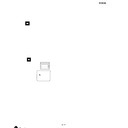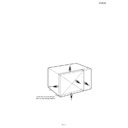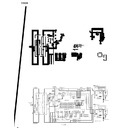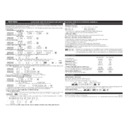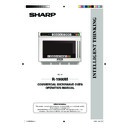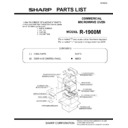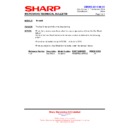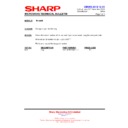Sharp R-1900M (serv.man7) Service Manual ▷ View online
R1900M
6 – 2
JUDGEMENT: The measured output power should be at least
± 15% of the rated output power.
CAUTION: 1
°C CORRESPONDS TO 150 WATTS. REPEAT MEASUREMENT IF THE POWER IS INSUFFICIENT.
2. MICROWAVE OUTPUT POWER (2000 cc alternative method)
The power output of this oven is rated using the method specified by IEC 60705. Full details of how to curry out this procedure can be found in the
Sharp Technical Training notes which is available from Sharp Parts Centre (part number SERV-LITMW01).
Sharp Technical Training notes which is available from Sharp Parts Centre (part number SERV-LITMW01).
The IEC-60705 procedure must be carried out using laboratory-type procedures and equipment.
These requirements make the procedure unsuitable for routine performance checks.
NOTE: The following test method gives an indication of the output power only, it cannot be used to establish the actual/rated output power. If the true
output power is required, then the IEC60705 test method must be used.
Alternative simplified method:
1. Place 2 litres of cold water (between 12
°C and 20°C) in a suitable container.
2. Stir the water and measure the temperature in
°C. Note temperature as T1.
3. Place the container in the microwave and heat the water for 47 sec. on full power.
4. When the 47 sec. is completed, remove the container and stir the water. Note temperature as T2.
5. Calculate the output power using the following formula:
R.F. Power Output = (T2 - T1) x 190.
NOTE: The result from this test should be within the allowance of 2000cc alternative method. (
±10%).
3. MICROWAVE LEAKAGE TEST
This oven should be tested for microwave leakage on completion of any repair or adjustment, following the procedure described in the Sharp Techni-
cal Training notes (part number SERV-LITMW01). The maximum leakage permitted in BS EN 60335-2-25 is 50W/m
cal Training notes (part number SERV-LITMW01). The maximum leakage permitted in BS EN 60335-2-25 is 50W/m
2
(equivalent to 5W/m
2
), however
it is not normal to detect any significant leakage, therefore, any leakage which is detected should be investigated.
It is essential that only leakage detectors with current calibration traceable to National Physical Laboratories are used.
Suitable leakage detectors: CELTEC A100 / APOLLO X1
[2] B: POWER TRANSFORMER TEST
1. CARRY OUT 3D CHECKS.
2. Disconnect the leads to the primary winding of the power transformer. Disconnect the filament and secondary winding connections from the rest of
the HV circuitry. Using an ohmmeter, set on a low range, it is possible to check the continuity of all three winding. The following readings should be
obtained:
obtained:
a.Primary winding -------------------- approximately 1.3
Ω
b.Secondary winding --------------- approximately 76
Ω
c.Filament winding --------------------------- less than 1
Ω
If the readings obtained are not stated as above, then the power transformer is probably faulty and should be replaced.
3. CARRY OUT 4R CHECKS.
Room temperature ................................................................. To = 21
°C
Initial temperature .................................................................. T1 = 11
°C
Temperature after (22 + 3) = 25 sec. ...................................... T2 = 21
°C
Temperature difference Cold-Warm ..................................... T1 = 10
°C
Measured output power
The equation is “P = 190 x T" .................... P = 190 x 10
The equation is “P = 190 x T" .................... P = 190 x 10
°C = 1900 Watts
WARNING: High voltages and large currents are present at the secondary winding and filament winding of the power transformer. It is
very dangerous to work near this part when the oven is on. NEVER make any voltage measurements of the high-voltage cir-
cuits, including the magnetron filament.
cuits, including the magnetron filament.
1000g
1000g
1000g
T1 C
T2 C
Heat up for 25 sec.
R1900M
6 – 3
[3] C: HIGH VOLTAGE RECTIFIER (1) AND/OR (2) TEST
1. HIGH VOLTAGE RECTIFIERFTEST
1. CARRY OUT 3D CHECKS.
2. Isolate the high voltage rectifier assembly from the HV circuit. The high voltage rectifier can be tested using an ohmmeter set to its highest range.
Connect the ohmmeter across the terminal B+C of the high voltage rectifier and note the reading obtained. Reverse the meter leads and note this
second reading. The normal resistance is infinite in one direction and more than 100k ohms in the other direction.
second reading. The normal resistance is infinite in one direction and more than 100k ohms in the other direction.
3. CARRY OUT 4R CHECKS.
2. ASYMMETRIC RECTIFIER TEST
1. CARRY OUT 3D CHECKS.
2. Isolate the high voltage rectifier assembly from the HV circuit. The asymmetric rectifier can be tested using an ohmmeter set to its highest range
across the terminals A+B of the asymmetric rectifier and note the reading obtained. Reverse the meter leads and note this second reading. If an
open circuit is indicated in both directions then the asymmetric rectifier is good. If the asymmetric rectifier is shorted in either direction, then the
asymmetric rectifier is faulty and must be replaced with high voltage rectifier. When the asymmetric rectifier is defective, check whether magne-
tron, high voltage rectifier, high voltage wire or filament winding of the power transformer is shorted.
open circuit is indicated in both directions then the asymmetric rectifier is good. If the asymmetric rectifier is shorted in either direction, then the
asymmetric rectifier is faulty and must be replaced with high voltage rectifier. When the asymmetric rectifier is defective, check whether magne-
tron, high voltage rectifier, high voltage wire or filament winding of the power transformer is shorted.
3. CARRY OUT 4R CHECKS.
NOTE: Be sure to use an ohmmeter that will supply a forward bias voltage of more than 6.3 volts.
[4] D: HIGH VOLTAGE CAPACITOR (1) AND/OR (2) TEST
1. CARRY OUT 3D CHECKS.
2. If the capacitor is open, no high voltage will be available to the magnetron. Disconnect input leads and check for short or open between the termi-
nals using an ohmmeter.
Checking with a high ohm scale, if the high voltage capacitor is normal, the meter will indicate continuity for a short time and should indicate an
open circuit once the capacitor is charged. If the above is not the case, check the capacitor with an ohmmeter to see if it is shorted between either
of the terminals and case. If it is shorted, replace the capacitor.
open circuit once the capacitor is charged. If the above is not the case, check the capacitor with an ohmmeter to see if it is shorted between either
of the terminals and case. If it is shorted, replace the capacitor.
3. CARRY OUT 4R CHECKS.
[5] E: SECONDARY INTERLOCK SWITCH (1) AND/OR (2) TEST
1. CARRY OUT 3D CHECKS.
2. Isolate the switch and connect the ohmmeter to the common (COM.) and normally open (NO) terminal of the switch. The meter should indicate an
open circuit with the door open and a closed circuit with the door closed. If improper operation is indicated, replace the secondary interlock switch.
3. CARRY OUT 4R CHECKS.
[6] F: PRIMARY INTERLOCK SYSTEM TEST
1. DOOR SENSING SWITCH
1. CARRY OUT 3D CHECKS.
2. Isolate the switch and connect the ohmmeter to the common (COM.) and normally open (NO) terminal of the switch. The meter should indicate an
open circuit with the door open and a closed circuit with the door closed. If improper operation is indicated, replace the door sensing switch.
3. CARRY OUT 4R CHECKS.
2. PRIMARY INTERLOCK RELAY RY1
1. CARRY OUT 3D CHECKS.
2. Disconnect two (2) wire leads from the male tab terminals of the Primary Interlock Relay RY1. Check the state of the relay contacts using a ohm-
meter. The relay contacts should be open. If the relay contacts are closed, replace the circuit board entirely or the relay itself.
3. CARRY OUT 4R CHECKS.
[7] G: MONITOR SWITCH (1) AND/OR (2) TEST
1. CARRY OUT 3D CHECKS.
D2
D1
ASYMMETRIC
RECTIFIER
HIGH VOLTAGE
RECTIFIER
A
B
C
R1900M
6 – 4
2. Before performing this test, make sure that the secondary interlock switches (1), (2) and the primary interlock relay RY1 are operating properly,
according to the above Switch Test Procedure. Disconnect the wire lead from the monitor switches (1), (2) (COM) terminals. Check the monitor
switches (1), (2) operation by using the ohmmeter as follows. When the door is open, the meter should indicate a closed circuit. When the monitor
switch actuator is pushed by a screw driver through the upper latch hole on the front plate of the oven cavity with the door opened (in this condition
the plunger of the monitor switch is pushed in), the meter should indicate an open circuit. If improper operation is indicated, the switch may be
defective. After testing the monitor switches, reconnect the wire lead to the monitor switch (COM) terminals and check the continuity of the monitor
circuit.
switches (1), (2) operation by using the ohmmeter as follows. When the door is open, the meter should indicate a closed circuit. When the monitor
switch actuator is pushed by a screw driver through the upper latch hole on the front plate of the oven cavity with the door opened (in this condition
the plunger of the monitor switch is pushed in), the meter should indicate an open circuit. If improper operation is indicated, the switch may be
defective. After testing the monitor switches, reconnect the wire lead to the monitor switch (COM) terminals and check the continuity of the monitor
circuit.
3. CARRY OUT 4R CHECKS.
[8] H: FUSE F10 TEST
1. CARRY OUT 3D CHECKS.
2. If the fuse F10 (1) or (2) is blown when the door is opened, check the primary interlock relay RY1, secondary interlock switches (1), (2) and moni-
tor switches (1), (2) according to the “TEST PROCEDURE” for those switches before replacing the blown fuse F10 (1) or (2).
CAUTION: CAUTION: BEFORE REPLACING A BLOWN FUSE F10 (1) OR (2), TEST THE PRIMARY INTERLOCK RELAY, SECONDARY INTER-
LOCK SWITCHES, DOOR SENSING SWITCH AND MONITOR SWITCHES FOR PROPER OPERATION.
3. If the fuse is blown, check the magnetron, high voltage capacitor, high voltage rectifier assembly, according to the “TEST PROCEDURE” before
replacing the blown fuse. Then replace the fuse.
4. CARRY OUT 4R CHECKS.
[9] I: WEAK POINT (FOR FAN MOTOR OR EXHAUST FAN) TEST
CARRY OUT 3D CHECKS.
If the weak point is blown, the fan motor or exhaust fan could be locked or there could be a shorts in the fan motor or exhaust fan. Check them and
replace the defective parts.
replace the defective parts.
CARRY OUT 4R CHECKS.
CAUTION: Only replace weak point with the correct value replacement.
[10] J: WEAK POINT (IN NOISE FILTER) TEST
CARRY OUT 3D CHECKS.
If the weak point is blown, there could be a shorts or grounds in electrical parts or wire harness. Check them and replace the defective parts or repair
the wire harness.
the wire harness.
CARRY OUT 4R CHECKS.
CAUTION: Only replace weak point with the correct value replacement.
[11] K: TEMPERATURE FUSE TEST
1. CARRY OUT 3D CHECKS.
2. A continuity check across the temperature fuse terminals should indicate a closed circuit unless the temperature of the temperature fuse reaches
specified temperature as shown below.
Open temperature
Close temperature
Display or
Condition
Check point
Magnetron temperature
fuse (1)
fuse (1)
150
°C
Non resetable type
EE1
Magnetron (1) Failure:
Test magnetron (1) and fan motor.
Test magnetron (1) and fan motor.
Magnetron temperature
fuse (2)
fuse (2)
EE2
Magnetron (2) Failure:
Test magnetron (2) and fan motor.
Test magnetron (2) and fan motor.
Magnetron temperature
fuse (1), (2)
fuse (1), (2)
EE3
Magnetron (1), (2) Failure: Test magnetron (1), (2).
Check fan motor and ventilation opening.
Check fan motor and ventilation opening.
Oven temperature fuse
120
°C
Non resetable type
Oven shut off
Food has been burned in oven.
Temperature of oven inside is very high.
Temperature of oven inside is very high.
Screw Driver
Ohmmeter
Monitor switch (2)
Latch hook
Monitor switch (1)
R1900M
6 – 5
3. CARRY OUT 4R CHECKS.
CAUTION: IF THE TEMPERATURE FUSE INDICATES AN OPEN CIRCUIT AT ROOM TEMPERATURE, REPLACE TEMPERATURE FUSE.
[12] L: MAGNETRON THERMISTOR TEST
1. CARRY OUT 3D CHECKS.
2. Disconnect the connector of the magnetron thermistor from the harness. Measure the resistance of the thermistor with an ohmmeter. Connect the
ohmmeter leads to the connector of the thermistor.
If the meter does not indicate above resistance, replace the thermistor.
3. CARRY OUT 4R CHECKS.
[13] M: EXHAUST THERMISTOR TEST
The exhaust thermistor can be checked by using the Special function (SF-6). Check the exhaust thermistor, referring to the pages of the Exhaust ther-
mistor check (SF-6).
mistor check (SF-6).
If the display shows “OH”, the exhaust thermistor is normal. If the display shows “no”, the exhaust thermistor is abnormal and it should be replaced.
[14] N: NOISE FILTER TEST
1. CARRY OUT 3D CHECKS.
2. Disconnect the lead wires from the terminal the noise filter. Using an ohmmeter, check
between the terminals as described in the following table. If incorrect reading are obtained,
replace the noise filter.
replace the noise filter.
3. CARRY OUT 4R CHECKS.
[15] O: KEY UNIT TEST
1. CARRY OUT 3D CHECKS.
2. Check Key unit ribbon connection before replacement.
3. If key unit ribbon connection is normal, carry out the following procedures.
4. Re-install the rear cover and the outer case (cabinet).
5. Reconnect the power supply cord.
6. The following symptoms indicate a defective key unit.
1) When touching the pads, a certain pad produces no signal at all.
2) When touching a number pad, two figures or more are displayed.
3) When touching the pads, sometimes a pad produces no signal.
7. When you can not judge if the key unit is normal or not by using the item 8 above, carry out following test procedures.
1) Disconnect the power supply cord, and then remove outer case and rear cover.
2) Open the door and block it open.
3) Discharge two high voltage capacitors.
4) Disconnect the leads to the primary of the power transformer.
5) Ensure that these leads remain isolated from other components and oven chassis by using
insulation tape.
6) Reconnect the power supply cord.
Room temperature
Resistance
20
°C
Approx. 750K
Ω
MEASURING POINT
INDICATION OF OHMMETER
Between source terminals
Approx. 470K
Ω
Between source (Black) and load (Black) terminals
Short circuit.
Between source (White) and load (White/Brown) terminals
Short circuit.
WEAK
POINT
NOISE FILTER
NOISE SUPPRESSION COIL
LINE CROSS CAPACITOR
1.0μF / AC 275V
DISCHARGE RESISTOR
470K 1/2W
LINE BYPASS
CAPACITOR
0.0033μF / AC 250V
LINE BYPASS
CAPACITOR
0.0033μF / AC 250V
Load
(Black)
Load
(Gray/White)
Source
(Blue)
Source
(Brown)
5
4
3
2
7
8
9
6
1
2
3
4
3
4
1
5
6
7
2
3
4
3
4
1
5
6
7
2
3
4
3
4
1
5
6
7
8
8
STOP
CLEAR
1
START
3
4
9
5
6
0
7
8
STOP
CLEAR
1
2
X2/X3
START
3
4
9
5
6
0
7
8
CN-M
CN-R
CN-Z
2
CUSTOM
SETTING
SET
MEMORY
EXPRESS
DEFROST
MANUAL
REHEAT
POWER
LEVEL
CN-Q
< DOOR KEY UNIT >
< KEY UNIT >
< SW UNIT >
Display




